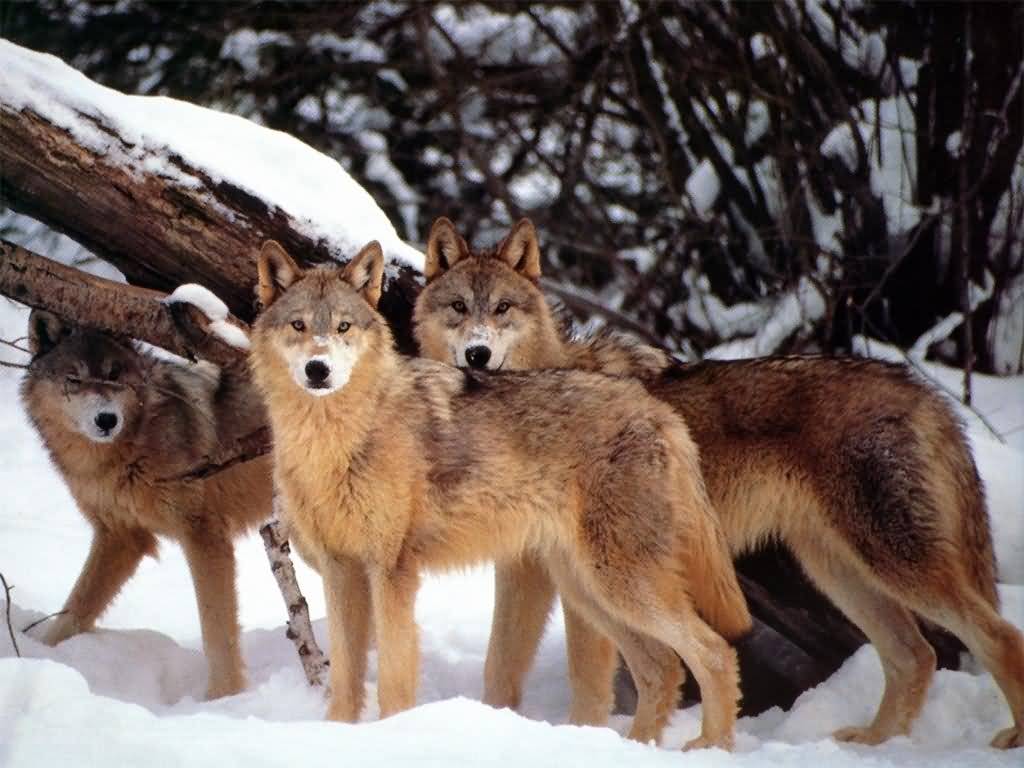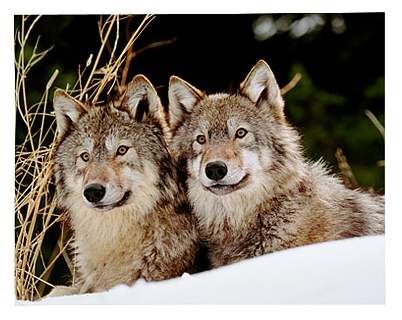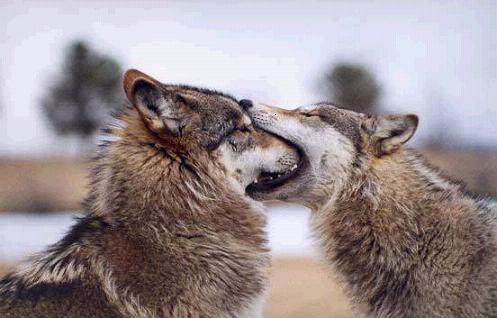Introduction
Any person who has been able to catch a glimpse of any type of wolf is indeed a lucky man. The wolf is one of the earth’s most cowardly and fearful animals, and it is so sly and, pardon the expression, foxy, that it is almost a waste of time to try and catch him in any kind of trap. Although he can be cowardly and fearful, he can also be one the most vicious and blood-thirsty of all animals. Wolves are among some of the world’s smartest and most perceptive mammals.
Where Found
Wolves are found all over the world, and on almost every major continent of the earth. The following wolves are types of Gray Wolves (Canis lupus). In Eastern Europe the European Wolf (Canis lupus lupus) can be found even though it used to roam most of Western Europe as well. In Spain, two wolves have also been identified-Canis lupus deitanus and Canis lupus signatus.
While the first is similar to many of the other European wolves, the latter may be more closely related to the jackal (Canis aureus), than to a wolf. The Caucasion Wolf (Canis lupus cubanensis) is found in many parts of Eastern Europe and western Asia. The large tundra wolf of eastern Asia, the Tundra or Turukhan Wolf (Canis lupus albus), is very close in relations to the wolves of northern Alaska.
In the Arctic Islands and Greenland the Melville Island Wolf (Canis lupus arctos), the Banks Island Wolf (Canis lupus bernardi), the Baffin Island Wolf (Canis lupus manningi), and the Greenland wolf (Canis lupus orion), are all found. Wolves of the Continental Tundra and Newfoundland include the Alaska Tundra Wolf (Canis lupus tundrarum), the Interior Alaska Wolf (Canis lupus pambasileur), the Kenai Peninsula Wolf (Canis lupus alces), the Mackenzie Tundra Wolf (Canis lupus mackenzii), the Mackenzie Valley Wolf (Canis lupus occidentalis), the Hudson Bay Wolf (Canis lupus hudsonicus), the Labrador Wolf (Canis lupus labradorius), and the Newfoundland Wolf (Canis lupus beothicus).
However, the Newfoundland wolf has seemed to become extinct. This is strange because there is no evidence of them being intensely hunted by man, of extreme habitat changes, or of lack of food and yet in the early 1900s they became extinct. The wolves of the Western Mountains and Coast of North America include the British Columbia Wolf (Canis lupus colombianus), the Alexander Archipelago Wolf (Canis lupus ligoni), the Vancouver Island Wolf (Canis lupus crassodon), the Cascade Mountain Wolf (Canis lupus fuscus), the Northern Rocky Mountain Wolf (Canis lupus irremotus), the Southern Rocky Mountain Wolf (Canis lupus youngi), and the Mogollon Mountain Wolf (Canis lupus mogollonensis).
Of these wolves, the British Columbia Wolf is the largest. The last two of these wolves have now been exterminated due to the killings by man. The Mexican Wolf (Canis lupus baileyi) is the smallest of the subspecies of the wolves found in the Americas. They could be found in the area of Northern Chihuahua and other parts of Mexico and the southern United States, especially Texas.
The Texas Gray Wolf (Canis lupus monstrabilis) is obviously larger than the Mexican Wolf and used to be commonly found in Texas. Now, both of these subspecies have been exterminated in the United States but still can be found in the Sierra Madre Occidental and the mountains of western Coahuila and eastern Chihuahua, in Mexico. The Eastern of Timber Wolf (Canis lupus lycaon) and the Great Plains or Buffalo Wolf (Canis lupus nubilus) could originally be found on almost 25% of North America.
Today, however, due to competition with settlers, the Buffalo Wolves were exterminated by the early 1900s. The Timber Wolf, for the same reason, can no longer be found in the United States, but still is common in Ontario and Quebec. There are three main subspecies of Red Wolves (Canis niger).
They include the Florida Red Wolf (Canis niger niger), the Mississippi Valley Red Wolf (Canis niger gregoryi), and the Texas Red Wolf (Canis niger rufus). Gray wolves and red wolves can usually be distinguished by size. In most cases, the gray wolves are larger than red wolves with the exception that some of the larger red wolves may be bigger than the smaller gray wolves. They can also be distinguished by identifying a knob, “called cingulum, on the upper carnassials, or shearing teeth of the red wolf.”
However, this method, also, is not altogether full-proof. In some cases, a timber wolf will have a cingulum and an occasional red wolf will not have one at all. This method of using the cingulum to distinguish the wolves can also be deceiving in that almost all coyotes have a cingulum just like the red wolves.
Characteristics
The Red Wolf and the Gray Wolf are both from the family Canidae. This family includes the coyote, jackal, dingo, domestic dog, fox, bush dog, hunting dog, dhole, and the wolf.
The wolf has long and powerful legs, as well as mighty stamina, that allows it to spend eight to ten hours a day on the move and in search of food. The wolves usually travel during the night times or in the cool temperatures during dawn and dusk.
They usually travel at an average speed close to five miles per hour, but they can run up to 25 miles per hour. Wolves, like most canids, are digitigrade with five toes on front feet and four on hind feet. They are equipped with short, thick claws that give them good traction for running.
Wolves are very well-equipped for the hunt. They have 42 teeth that are backed up by incredibly strong jaw muscles. They usually can track their prey with their keen sense of smell that, if downwind, can detect prey at up to around 300 yards. An interesting aspect is the manner in which wolves are what is known as the “conversation of death.” Wolves often test large prey, and in approaching whatever this might be, a moose, caribou, elk, or bison, they engage their prey’s gaze with a sober stare.
Man has not been able to translate this “phenomenon” any more than he has been able to translate the meaning and significance of howling. However, it has been suggested that with this momentary, silent communication it is decided whether the hunt will be stopped or if a chase will follow. Gray wolves (Canis lupus) generally have fairly heavy coats that provide good insulation in cold weather.
The first layer is a fine underfur and the second layer is made up of long guard hairs that shed moisture and keep the underfur dry. Wolves can live in temperatures as cold as -40 degrees Fahrenheit. The coats of gray wolves vary in color from gray to black, and sometimes from brownish gray to brownish white. Many of their hairs can be black-tipped which results in irregular, wavy black markings that are concentrated in the middle of the back. The young of wolves are, throughout, grayer than the adults.
Red wolves (Canis niger) tend to be beautifully colored, with some black and dark gray, brown, cinnamon, and buff. Their tails are generally the same as the rest of the fur, but are usually dark-tipped. The color of these wolves also tends to vary with the season and with the geographic location.
Wolves from Chihuahua tend to be “grizzled on the back and flanks,” whereas “these parts are more tawny or brindled on wolves from southern Durango.” The fur of red wolves also tends to be thinner than that of the grey wolves. This is because they tend to live in areas with much warmer climates than the areas of the grey wolves.
The size of wolves can vary somewhat, but most wolves are relatively close in size. Wolves are sexually dimorphic: the male wolves are measurably larger than the females. The average length of male wolves is about 4.5-5.5 feet and the average height, at the shoulders is approximately 27-33 inches.
Their tales are between 14 and 17 inches long, and they range in weight from 70 to 100 pounds. The females are usually 4-5 feet long, 25-30 inches in height at the shoulders, and have tails 12- 15 inches long. They usually weigh between 50 and 80 pounds.
How it interacts with the Environment
For wolves, the pack is the basic unit, which can vary from 2 to 15 or more wolves. They travel, hunt, feed, and rest together. In each pack, there is a specific order of rank and a well-developed social system.
The highest-ranking male, the alpha male, is dominant to all others and directs the pack’s activities. The alpha female is dominant over all other females. Each pack may also include pups, juveniles, and older, more mature wolves.
The pack is very family-oriented and there are strong bonds of attachment within each pack. The socialization of pups begins when they start to appear outside of the den.
Here they establish dominant relations among littermates through “play fighting.” Younger males, not pups, but not adults yet, prepare for adulthood in many ways. One of these ways is by chasing deer. However, they do not chase to kill, but rather to practice, sharpen their hunting skills, and train themselves.
In a pack, it is important that the dominant wolves are easily distinguished from the submissive ones. To avoid fighting within the pack wolves have ritualized behaviors, postures, and gestures that are used to show dominance. A dominant wolf will assert himself by standing erect, ears and tail up, eyes open, teeth bared, and body hairs erect.
The subordinate wolf will show his submission by slumping down, laying back his ears, putting his tail between his legs, closing his mouth, and slightly closing his eyes. The submissive wolf may, in some cases, lie belly up to show his submission.
Wolves are very territorial and mark out their territories by chemical signals. Among these are urine, feces, and secretions. Wolves usually have a regular pattern of visiting and marking their territories every few weeks. Through observation, it has been shown that, while on the move, an alpha male will stop and mark every two minutes.
Wolves also use these scents to recognize which individuals have been to the given area. Wolves are well-known for hunting large animals. They will hunt and kill large animals such as moose, deer, caribou, mountain sheep, elk, bison, and musk-ox, but, seasonally, they will also eat rodents, hares, birds, fish, insects, and even carrion.
While wolves must kill many animals for the pack to survive, most cases do not end with a kill. Wolves react to how the prey reacts first, and it has been shown that they seem to need the stimulus of prey running away to start chasing after him. In the case of a kill, the wolf can consume up to 20 pounds and can then go for several days without eating.
Miscellaneous
Wolves and humans have had very intricate and close relationships for thousands of years. They are also very similar in many ways. The wolf and man are known as “apex hunters,” that is, they hunt at the top of their food chain and, except for each other neither has to compete with any other animal or enemy for their biological niche.
Another similarity between man and wolf is the pack. Hominid hunter-gatherer clans stayed in groups of about 15 (even though they ranged from 5 to 50, or greater, this was the average size) and would travel over a territory of 500 to 1000 square miles in search of food. Wolves, in packs of about ten, cover approximately the same size area.
Few other animals would ever travel in such wide-ranging parties made up of so few members.
Within the past two decades, Americans have developed a longing and a want for wolves and dogs that have high proportions of wolf blood. People fall in love with the wild elegance of the animals and the affectionate interaction that can take place between them and the animal, but wolves being kept in the house almost inevitably become a fatal attraction- usually for the wolf.
While the wolves are still pups they behave with a playful and rough affection that is cute while the animal is young. But as the animal matures, its predisposed nature of being a highly territorial predator emerges. This leads to conflict between the wolf and the owner who has bought it for its wild appeal but then expects it to act like a domesticated pet.
Whether by biting people, urinating all over the house or by tearing up cabinets and furniture, the wolf will exhaust its owner and the wolf will no longer be as cute as it seemed it would be. Wolves are not monstrous killing machines, but they are wild animals and the best advice that can be given to anyone considering the purchase of a wolf or wolf hybrid is not to.
Wolves have been in constant conflict with man. Sadly, the extermination of wolves has taken place in more than 95% of the 48 United States, much of Mexico, parts of Canada, most of Europe, and most of the Soviet Union. The status of the wolf in the lower 48 states is endangered.
Areas in northern Minnesota and Isle Royale have been declared “Critical Habitat” and have been protected from destruction or adverse modification. In Alaska, hunting of the animal is permitted since the wolf is not included on the Endangered Species List there. In Norway, Sweden, Italy, Israel, India, and Mexico the wolf is totally protected by law although protection is often minimally enforced.
Man holds the future of the wolf in his hands; the wolf is fully capable of surviving if a man learns to understand it and therefore learns to appreciate it and value it.




This really helped me on my wolf report
This is not enough information about grey wolf characteristics.
This is amazing! Its really going to help me
I’m trying to do research on wolves.
Same, I’m writing a story on wolves and this helped out tons!
this was amazingly good information and it helps my essay and my brain
Hey, this helped a lot! Thank you so much!!
I love wolves thx for this
thanks man…. this helps with my bio project
it helped on my project on biodiversity
same!
its good!
This site is really fascinating about my favorite animal and helped me write my speech
thanks a lot it helped for information on my essay
the same for me
thanks, needed it for a writing essay about Chinese zodiac animals. I had to come up with a new one.
I was just wondering where all of the information came from? Was it from a scientific article or was it from various internet sites?
Awesome! Gives me LOTS OF information!
Thx, this helped with my PowerPoint presentation.
I LOVE WOLVES, thanks
cool
it is an amazing story and truly is very helpful
it is cool, thanks
helpful
thanks
this website was very nice for homework or school work thats why its called school network
thx for the info really helped me in my science project
Excellent, thank you
this will help with my essay on DNA splicing
wow, It’s very nice
Thanks for the information, it really helped me with my English HW
hey, it helped me.